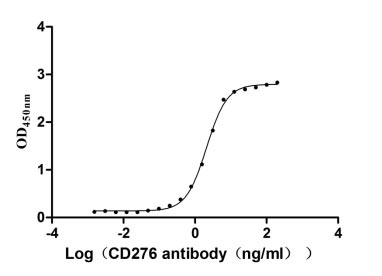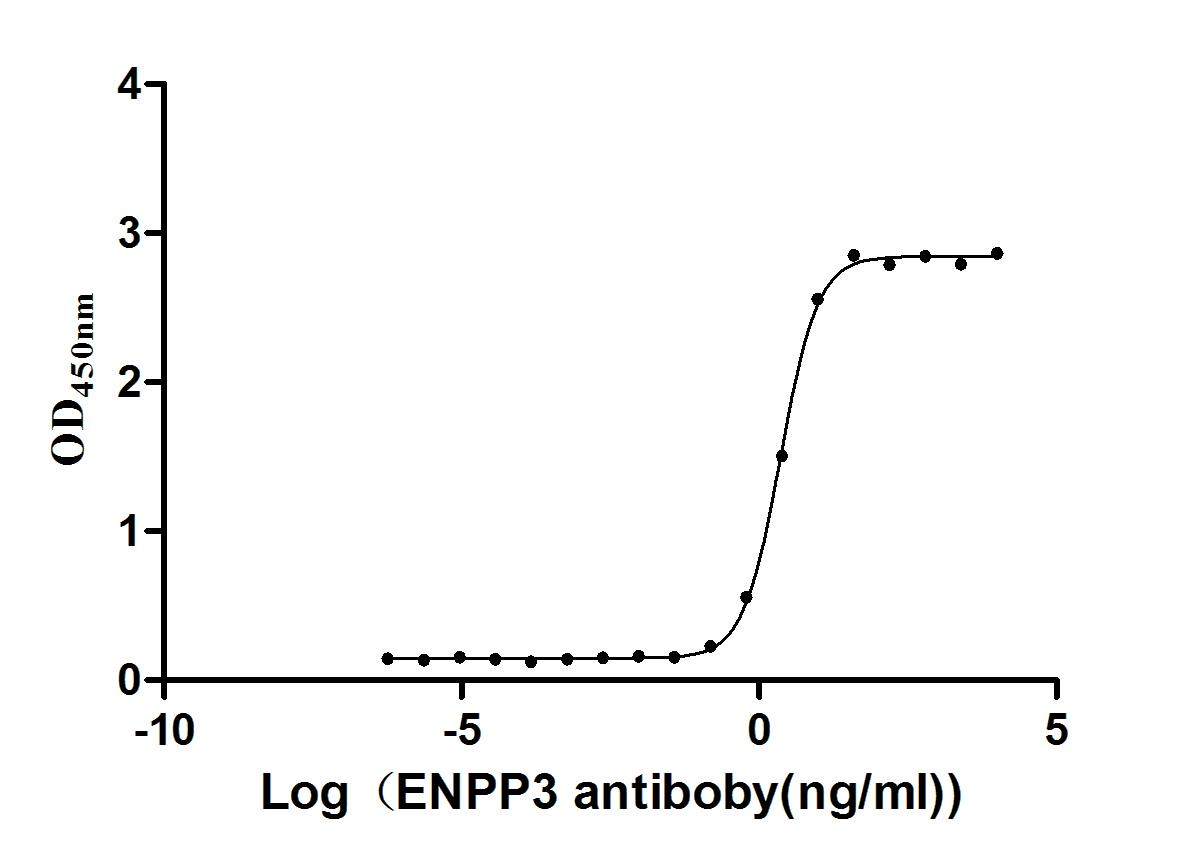Recombinant Saccharomyces cerevisiae Polyadenylate-binding protein, cytoplasmic and nuclear (PAB1), partial
-
中文名稱(chēng):釀酒酵母PAB1重組蛋白
-
貨號(hào):CSB-YP361215SVG
-
規(guī)格:
-
來(lái)源:Yeast
-
其他:
-
中文名稱(chēng):釀酒酵母PAB1重組蛋白
-
貨號(hào):CSB-EP361215SVG
-
規(guī)格:
-
來(lái)源:E.coli
-
其他:
-
中文名稱(chēng):釀酒酵母PAB1重組蛋白
-
貨號(hào):CSB-EP361215SVG-B
-
規(guī)格:
-
來(lái)源:E.coli
-
共軛:Avi-tag Biotinylated
E. coli biotin ligase (BirA) is highly specific in covalently attaching biotin to the 15 amino acid AviTag peptide. This recombinant protein was biotinylated in vivo by AviTag-BirA technology, which method is BriA catalyzes amide linkage between the biotin and the specific lysine of the AviTag.
-
其他:
-
中文名稱(chēng):釀酒酵母PAB1重組蛋白
-
貨號(hào):CSB-BP361215SVG
-
規(guī)格:
-
來(lái)源:Baculovirus
-
其他:
-
中文名稱(chēng):釀酒酵母PAB1重組蛋白
-
貨號(hào):CSB-MP361215SVG
-
規(guī)格:
-
來(lái)源:Mammalian cell
-
其他:
產(chǎn)品詳情
-
純度:>85% (SDS-PAGE)
-
基因名:PAB1
-
Uniprot No.:
-
別名:PAB1; YER165WPolyadenylate-binding protein; cytoplasmic and nuclear; PABP; Poly(A)-binding protein; ARS consensus-binding protein ACBP-67; Polyadenylate tail-binding protein
-
種屬:Saccharomyces cerevisiae (strain ATCC 204508 / S288c) (Baker's yeast)
-
蛋白長(zhǎng)度:Partial
-
蛋白標(biāo)簽:Tag?type?will?be?determined?during?the?manufacturing?process.
The tag type will be determined during production process. If you have specified tag type, please tell us and we will develop the specified tag preferentially. -
產(chǎn)品提供形式:Lyophilized powder
Note: We will preferentially ship the format that we have in stock, however, if you have any special requirement for the format, please remark your requirement when placing the order, we will prepare according to your demand. -
復(fù)溶:We recommend that this vial be briefly centrifuged prior to opening to bring the contents to the bottom. Please reconstitute protein in deionized sterile water to a concentration of 0.1-1.0 mg/mL.We recommend to add 5-50% of glycerol (final concentration) and aliquot for long-term storage at -20℃/-80℃. Our default final concentration of glycerol is 50%. Customers could use it as reference.
-
儲(chǔ)存條件:Store at -20°C/-80°C upon receipt, aliquoting is necessary for mutiple use. Avoid repeated freeze-thaw cycles.
-
保質(zhì)期:The shelf life is related to many factors, storage state, buffer ingredients, storage temperature and the stability of the protein itself.
Generally, the shelf life of liquid form is 6 months at -20°C/-80°C. The shelf life of lyophilized form is 12 months at -20°C/-80°C. -
貨期:Delivery time may differ from different purchasing way or location, please kindly consult your local distributors for specific delivery time.Note: All of our proteins are default shipped with normal blue ice packs, if you request to ship with dry ice, please communicate with us in advance and extra fees will be charged.
-
注意事項(xiàng):Repeated freezing and thawing is not recommended. Store working aliquots at 4°C for up to one week.
-
Datasheet :Please contact us to get it.
靶點(diǎn)詳情
-
功能:Binds the poly(A) tail of mRNA. Appears to be an important mediator of the multiple roles of the poly(A) tail in mRNA biogenesis, stability and translation. In the nucleus, interacts with the nuclear cleavage factor IA (CFIA), which is required for both mRNA cleavage and polyadenylation. Is also required for efficient mRNA export to the cytoplasm. Acts in concert with a poly(A)-specific nuclease (PAN) to affect poly(A) tail shortening, which may occur concomitantly with either nucleocytoplasmic mRNA transport or translational initiation. Regulates PAN activity via interaction with the stimulator PAN3 or the inhibitor PBP1. In the cytoplasm, affects both translation and mRNA decay. Stimulates translation by interaction with translation initiation factor eIF4G, a subunit of the cap-binding complex eIF4F, bringing the 5'- and 3'-ends of the mRNA in proximity. The formation of this circular mRNP structure appears to be critical for the synergistic effects of the cap and the poly(A) tail in facilitating translation initiation, recycling of ribosomes, and mRNA stability. Also regulates translation termination by recruiting eukaryotic release factor 3 (eRF3). Interaction with eRF3 is also required for regulation of normal mRNA decay through translation termination-coupled poly(A) shortening, probably mediated by PAN. Loss of PAB1 from the mRNP after deadenylation triggers mRNA degradation. Inhibits the major cytoplasmic mRNA deadenylase CCR4-NOT complex. Is also associated peripherally with COPI vesicles through its interaction with ARF1, and this is required for correct localization of the asymmetrically distributed ASH1 mRNA.
-
基因功能參考文獻(xiàn):
- The authors found that Pab1 association into these aggregates relies mainly on RNA recognition motifs, whose number is important for an efficient recruitment of the protein. PMID: 28873979
- Two distal RNA recognition motif of Sbp1 bind to the poly(A) sequence in the 5'UTR of the Pab1 mRNA specifically and cooperatively while the central RGG domain of the protein interacts directly with Pab1. PMID: 28986506
- Study shows that Pab1 phase separates and gels in response to physiological thermal and pH stresses, a demixing process, which is modulated by the P domain but does not require it; Poly(A)-binding protein thus acts as a physiological stress sensor, exploiting phase separation to precisely mark stress onset, a broadly generalizable mechanism. PMID: 28283059
- measured the contribution of each structural element in RRM2 domain to Pab1 performance, dissected the in vivo effects of mutations at known RNA-binding residues and other interaction sites, and identified non-RNA-binding residues essential to RRM2 function PMID: 24064791
- These results suggest that the RRM1 domain is the more critical region of PAB1 for controlling deadenylation and consists of at least two distinguishable functional regions. PMID: 23793387
- Data suggest that the low abundance may be partially attributable to inefficient translation initiation mediated by the binding of Pab1p to the long pre-AUG A29. PMID: 21840854
- Pab1 affects, but is not absolutely required for, stress granule formation. PMID: 20368989
- Pab1p inhibits the decapping reaction in a translation-independent manner in vivo PMID: 20732870
- proper loading of Pab1 onto mRNAs and final trimming of the tail allows release from transcription sites and couples pre-mRNA processing to export. PMID: 15630021
- These results suggest that polyadenylated mRNAs can enter P-bodies, and an mRNP complex including poly(A)(+) mRNA, Pab1p, eIF4E, and eIF4G2 may represent a transition state during the process of mRNAs exchanging between P-bodies and translation. PMID: 17475768
- PAB1 is not required for discrimination of nonsense-codon-containing mRNA from normal by nonsense-mediated mRNA decay. PMID: 18206975
顯示更多
收起更多
-
亞細(xì)胞定位:Cytoplasm. Nucleus. Note=Predominantly cytoplasmic. Rapidly shuttles between the nucleus and the cytoplasm. Can be exported from the nucleus through at least 2 distinct pathways, the main being dependent on the exportin CRM1, and the second requiring MEX67 and ongoing mRNA export. Import is mediated by the importin SXM1.
-
蛋白家族:Polyadenylate-binding protein type-1 family
-
數(shù)據(jù)庫(kù)鏈接:
KEGG: sce:YER165W
STRING: 4932.YER165W
Most popular with customers
-
Recombinant Human CD276 antigen (CD276), partial (Active)
Express system: Mammalian cell
Species: Homo sapiens (Human)
-
Express system: Mammalian cell
Species: Homo sapiens (Human)
-
Recombinant Rat Intestinal-type alkaline phosphatase 1 (Alpi) (Active)
Express system: Mammalian cell
Species: Rattus norvegicus (Rat)
-
Express system: Mammalian cell
Species: Homo sapiens (Human)
-
Recombinant Human Claudin-6 (CLDN6)-VLPs (Active)
Express system: Mammalian cell
Species: Homo sapiens (Human)
-
Recombinant Human Trophoblast glycoprotein (TPBG), partial (Active)
Express system: Mammalian cell
Species: Homo sapiens (Human)
-
Recombinant Human Glucagon-like peptide 1 receptor (GLP1R), partial (Active)
Express system: Mammalian cell
Species: Homo sapiens (Human)
-
Recombinant Human Gastric inhibitory polypeptide receptor(GIPR),partial (Active)
Express system: Mammalian cell
Species: Homo sapiens (Human)






-AC1.jpg)













